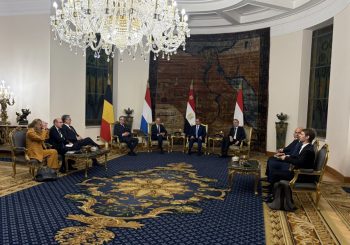Egypt, Ethiopia and Sudan have signed an agreement aimed at curbing Egypt’s alarm at the speed of which the Grand Ethiopian Renaissance Dam (‘the dam’) is being constructed. The agreement is based on a preliminary agreement that had been reached in March 2015 between the leaders of the three countries in Khartoum, Sudan.
According to Egyptian state media, it was agreed that a French consulting firm would conduct research for a period between eight months and a year.
Ethiopia has also agreed to not fill the dam with any water from the Nile River until some sort of consensus has been reached between the three countries. The agreement also states that regular meetings will be held to solve other disagreements between the three countries and to respond to all Egyptian concerns regarding the filling of the dam with water.
The agreement, which was signed after talks between foreign ministers of the three countries in Khartoum, is obligatory and shows that the three countries hope to solve the issue diplomatically in a way that results in stronger bilateral ties, said an Egyptian Foreign Ministry source to Egyptian Streets.
History of the Ethiopian Dam Crisis
During the ninth meeting of the three countries in Cairo on 8 and 9 November, Egypt denounced the speed of the construction of the dam and the delay of studies into the impacts of the dam.
Egypt’s main concern since the start of construction of the dam in 2011 is its high storage capacity, which reaches 74 billion cubic meters, over fears of affecting its national water security.
As per agreements signed in 1929 and 1959, downstream countries Egypt and Sudan together receive the majority of Nile Water. Egypt annually receives 55.5 billion cubic metres of the estimated total 84 billion cubic meters of Nile water produced each year, while Sudan receives 18.5 billion cubic meters.
Egypt initially condemned the dam’s construction, stating that Ethiopia decided to build the dam without informing other countries that may be impacted.
Currently, approximately 55 percent of the dam has been constructed despite no studies into the dam’s impact. Egypt is not only concerned that the dam will impact Egypt’s water supply, but would also have impacts on the environment and security (for example, in the case of an earthquake or a terror attack). Moreover, Egypt has also expressed worry that the dam would impact the generation of electricity by the Aswan High Dam.
How far Egypt would go to protect its rights in the Nile River remains unclear. However, analysts say international arbitration is far more likely than a military incursion in the case where all diplomatic paths have failed.







Comments (3)
[…] President, who personally attended the summit in Ethiopia despite a recent dispute over the Grand Ethiopian Renaissance Dam, was chosen earlier in 2015 as the Coordinator of the Committee of African Heads of State and […]
[…] http://egyptianstreets.com/2015/12/29/e … and-sudan/ […]